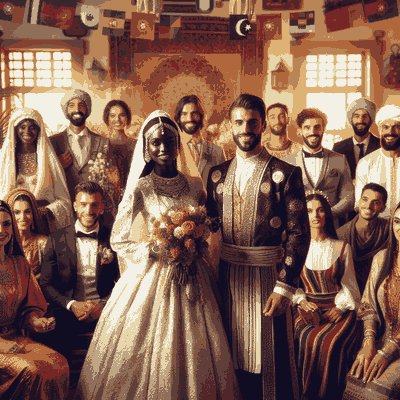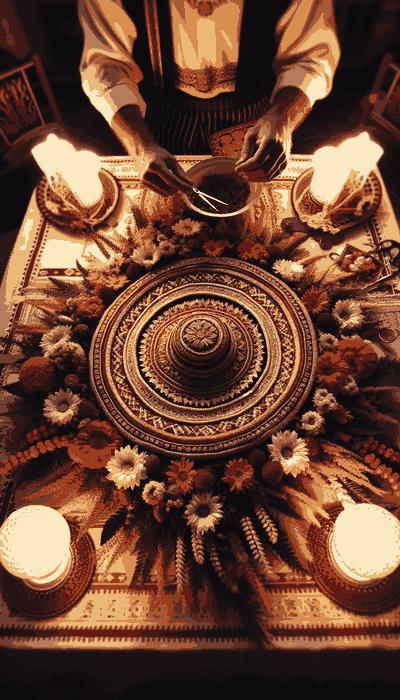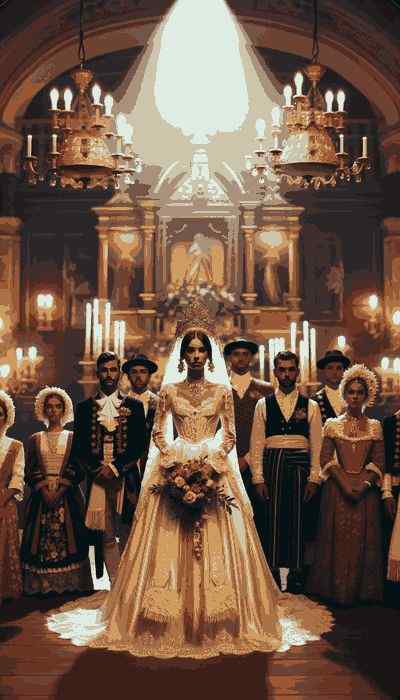Portuguese Wedding Traditions Complete Guide for Modern Couples
Picture this: The sweet aroma of freshly baked bread wafts through narrow cobblestone streets as church bells echo across ancient Portuguese villages. But Portuguese weddings hold secrets that go far beyond these postcard-perfect scenes. Did you know that some Portuguese brides still carry bread in their wedding gowns for good fortune? Or that wedding feasts can stretch until sunrise, with mysterious midnight traditions that few outsiders ever witness? From the bride’s hidden message in her shoes to the surprising reason Portuguese grooms keep sugar-coated almonds in their pockets, these celebrations are a tapestry of enchanting customs that have survived centuries. Discover how modern Portuguese couples are reinventing these time-honored traditions while keeping their magical essence alive. Join us as we unveil the captivating world of Portuguese wedding traditions, where every ritual tells a story and every celebration becomes an unforgettable journey through time.
Picture this: Church bells echo through cobblestone streets as hundreds of guests walk together, singing traditional songs. The bride’s grandmother adjusts her precious gold filigree necklace one last time. In the kitchen, aunties debate whether there’s enough caldo verdeKAL-doo VER-deh for 300 guests. This is a Portuguese wedding-where a single day stretches into an epic celebration of family, faith, and tradition that can last up to 24 hours.

The Portuguese Wedding Journey: From Blessing to Celebration

In Portugal, getting married isn’t just about two people saying “I do.” It’s a carefully choreographed dance between families that begins months-sometimes over a year-before the actual wedding day. The timeline tells its own story of anticipation:
The journey typically begins 12-18 months before the wedding with the father’s blessing, a moment that sets everything in motion. As the seasons change, families come together for planning meetings, church bookings are secured, and the all-important padrinhospah-DREEN-yoosh are chosen. By the time pre-wedding celebrations begin a month before the big day, entire communities are buzzing with excitement.
The wedding day itself transforms from intimate morning gatherings into afternoon ceremonies that flow seamlessly into receptions lasting until 3 or 4 in the morning. But even then, the celebration isn’t over-the tornabodator-nah-BOH-dah gathering the next day ensures the joy continues, and guest visitation traditions can extend the wedding season for weeks.
When Tradition Begins: Pre-Wedding Customs

The Sacred Moment of Pedido de Casamento
“A Bênçãoah BEN-sow”-the blessing. These two words carry the weight of centuries in Portuguese culture. When a young man decides to marry, he doesn’t just propose to his beloved; he formally requests her father’s blessing in a tradition that 65% of couples in traditional communities still honor today.
Imagine the scene: The groom arrives at his future father-in-law’s home, perhaps carrying a bottle of aged Port wine or a family heirloom. The conversation that follows isn’t just small talk-it’s a ritual that connects modern couples to medieval traditions of arranged marriages, transformed now into a symbol of respect and family unity.
The formal meeting, typically held 6-12 months before the wedding, often evolves into something much larger. What begins as a private conversation between two men can bloom into a family announcement gathering with 20-50 relatives, complete with traditional gift exchanges and formal dinners. In northern Portugal’s Minho region, these ceremonies maintain their formal structure, sometimes even including written agreements. Travel south to the Algarve, and you’ll find the same tradition expressed through relaxed family dinners where formality gives way to warmth.
Urban couples in Lisbon and Porto have reimagined this custom for modern times-35% now include both parents in the blessing ceremony, recognizing that marriage unites not just two people, but two families in their entirety.
Morning Gatherings: Where Joy Begins
As dawn breaks on the wedding day, something magical happens in Portuguese homes. The bride’s childhood home fills with the aroma of fresh pastéis de natapash-TEYS deh NAH-tah and the sound of clinking Port wine glasses. Meanwhile, across town, the groom’s house buzzes with its own preparations. These morning gatherings transform what could be stressful final preparations into joyful community events.
For 2-3 hours, 30-50 special guests-the inner circle of family and closest friends-create an atmosphere of celebration that sets the tone for the entire day. Local musicians might appear with traditional Portuguese guitars, their melodies floating through rooms where final dress adjustments happen alongside blessing prayers and spontaneous photo sessions.
The homemade pastries tell their own stories-each queijadakay-ZHAH-dah and regional sweet prepared by hands that have made them for generations. This pre-ceremony tradition shares DNA with Spanish wedding customs, where family involvement runs deep. Historically, Portuguese brides’ families organized 80% of wedding preparations, though today’s couples navigate a more balanced approach between both families.
The Sacred Ceremony: Where Faith Meets Tradition

Inside the Portuguese Catholic Wedding
Step inside a Portuguese church during a wedding, and you enter a space where time seems to slow. These aren’t quick ceremonies-Portuguese Catholic weddings unfold over 60-90 minutes, each moment steeped in religious significance and cultural meaning. Over 80% of Portuguese couples choose this traditional path, connecting their union to a faith tradition dating back to the 12th-century Reconquista.
The ceremony begins with the father walking his daughter down what often feels like an endless aisle-50 meters that represent her journey from one family to another. The church fills with the sound of scripture readings in both Portuguese and Latin, ancient words that have blessed countless unions before this one.
But the most touching moment often comes when the bride approaches the Virgin Mary’s altar. Clutching her bouquet, she places the flowers at the statue’s feet-a gesture of gratitude and a request for blessing that brings tears to many eyes. The church bells that ring as the couple exits don’t just announce a marriage; they proclaim a new beginning to the entire community.
Understanding the Padrinho Tradition
In Portuguese weddings, you won’t find matching bridesmaid dresses or coordinated groomsmen. Instead, you’ll meet the padrinhos-four wedding sponsors who represent something far more profound than aesthetic uniformity. These aren’t just witnesses; they’re mentors, guides, and active participants in the couple’s married life.
Choosing padrinhospah-DREEN-yoosh requires careful consideration. Ideally, they’re married couples with at least five years of experience navigating matrimony’s joys and challenges. Their responsibilities begin long before the wedding day and extend far beyond it. During the ceremony, they hold the rings, sign the registry, and offer readings. At the reception, they give speeches that blend humor with wisdom, organize traditional games, and manage the gift table.
What sets the padrinho system apart from Western wedding party traditions is its emphasis on ongoing support. These four individuals don’t just stand beside you on your wedding day-they stand beside your marriage for years to come, offering guidance when challenges arise and celebrating your milestones as their own.
The Community Procession: When Villages Celebrate Together
In small Portuguese communities, particularly in the north, weddings spill out of private venues and into public streets through the cortejo-the walking procession to church. Picture 50 to 200 people moving together through narrow village streets, their path decorated with flower petals, ribbons, and regional banners that flutter in the breeze.
This isn’t a silent march. Accordions, drums, and Portuguese guitars fill the air with traditional melodies. In Minho province, folk dancers in elaborate costumes lead the way. Travel to Trás-os-Montes, and you’ll hear the haunting sound of bagpipes accompanying the procession. Coastal villages add their own maritime flair with fishing nets and nautical decorations lining the route.
From windows and balconies, neighbors lean out to watch, some tossing flower petals, others calling out blessings. The 15-30 minute journey covers just 500-1000 meters, but it traverses centuries of tradition. Even urban adaptations, shortened to symbolic 50-100 meter walks, maintain the essence-community witness to the union being celebrated.
After "I Do": Post-Ceremony Celebrations

The Shower of Blessings
As church doors open and newlyweds step into the sunlight, the air fills with more than just celebration-it fills with rice, flower petals, or eco-friendly confetti, each grain or petal carrying wishes for fertility and prosperity. This ancient custom creates one of the wedding’s most photographed moments, with 100-300 guests each contributing their handful to the joyful chaos.
Regional preferences shape what flies through the air. In northern Portugal, traditional white rice remains the standard at 85% of weddings-5-10 kilograms creating a dramatic white shower. The Algarve’s venue restrictions have led to a preference for rose petals, while historic venues often require biodegradable alternatives. On the islands, couples might find themselves showered with petals from endemic flowers, adding local flavor to universal tradition.
La Noce: The Announcement on Wheels
What begins as a simple car ride transforms into La Noce-a decorated vehicle procession that announces the marriage to everyone within earshot. Born from walking processions of the 1950s, this tradition sees 30-50 cars adorned with white tulle, ribbons, and flowers following the newlyweds while maintaining a continuous symphony of honking horns.
The 5-15 kilometer journey takes 20-40 minutes, but its impact lasts much longer. At 80-90 decibels, the procession ensures no one misses the announcement. Modern safety considerations have added structure to the chaos-designated routes pre-approved by authorities, speed limits capped at 40 km/h, and professional decorators who can transform an entire fleet for €200-400.
Money Traditions: Practical Magic
Portuguese weddings blend celebration with practicality through money traditions that help newlyweds establish their household. The bride’s shoe becomes a traveling bank, passed among guests during dessert or dancing. As it makes its rounds among 100-200 guests, contributions of €5-20 per person accumulate into €500-1500-a significant start to married life.
The money dance adds entertainment to fundraising. For 30-60 seconds, guests pay for the privilege of dancing with the bride-€5-10 for friends, €20-50 for family members. The padrinho manages the queue as traditional Portuguese waltzes play, and another €300-800 finds its way to the couple. In Minho, these traditions become even more elaborate, sometimes including auctions. Urban areas prefer subtler collection methods, while maritime communities create nautical-themed variations.
The Feast of a Lifetime
Copo de Água: More Than Just a Reception
“Glass of Water”-the literal translation of Copo de ÁguaKOH-poo deh AH-gwah hardly captures the reality of a Portuguese wedding reception. This “glass” overflows with elaborate cocktail hours, multi-course dinners, and celebrations that refuse to end before 3 or 4 in the morning. With 150-300 guests and costs running €80-150 per person, Portuguese hospitality shows its true colors.
The timeline reads like a marathon of joy: Cocktail hour from 4:00-6:00 PM features 20-30 appetizer varieties-enough to constitute a meal anywhere else. By 7:00 PM, guests have found their seats and welcomed the couple’s grand entrance. The next four hours bring course after course of traditional delights, each more elaborate than the last.
But just when you think it’s winding down, the dessert stations open at 11:00 PM, followed by dancing that carries on past 1:00 AM. And because Portuguese hosts can’t bear the thought of guests going hungry, the ceia-late-night food service-ensures everyone has sustenance for dancing until dawn.
A Feast Fit for Tradition
The Portuguese wedding feast tells the story of a nation’s culinary heritage in 8-12 courses. This isn’t just dinner; it’s a journey through regional flavors and family recipes, where both meat and fish must appear to ensure prosperity.
The progression follows time-honored patterns: Those 20-30 cocktail hour appetizers include Portugal’s beloved codfish cakes and chouriçoshoh-REE-soo. The sit-down meal begins with soup-perhaps caldo verdeKAL-doo VER-deh from the north or a rich seafood bisque from coastal regions. The fish course showcases bacalhaubah-kahl-YOW or fresh catches, while the meat course might feature tender roasted lamb or pork, each plate a €15-30 investment in tradition.
Just when guests think they couldn’t eat another bite, the cheese buffet appears with 10-15 Portuguese varieties. And then-as if choreographed-the dessert table reveals itself: 30-40 varieties of traditional sweets that would make any pastry shop envious. Hours later, as energy flags, the late-night meal arrives: hearty sandwiches, soul-warming canjaKAHN-zhah soup, or filling feijoadafay-zhoo-AH-dah.
Wine flows throughout-Port for welcoming, regional varieties during dinner, vintage bottles for special toasts. The €15-30 per guest alcohol budget ensures glasses never empty, toasts never lack enthusiasm.
Sweet Traditions: Beyond the Wedding Cake
Forget the towering white cake-Portuguese weddings celebrate with dessert tables that could fill a pastry shop. These 30-50 varieties aren’t just sweets; they’re edible history, many recipes dating to 15th-century convents where nuns created masterpieces from egg yolks and sugar.
The stars of the dessert table each tell their own story. Bolo reiBOH-loo RAY, the king cake, costs €30-50 but brings royal treatment to the celebration. Hundreds of pastéis de natapash-TEYS deh NAH-tah disappear at €1 each, their flaky crusts and creamy centers familiar comfort to every guest. Toucinho do céutoh-SEEN-yoo doo SEH-oo“bacon from heaven” delivers almond and egg richness, while pão-de-lópow-deh-LOH provides the simple perfection of Portuguese sponge cake.
Regional variations add local flavor: the north contributes almond marzipan confections, Lisbon brings its famous conventual egg sweets, the Algarve adds citrus notes, and Madeira might sneak in some honey cake. The €500-1000 investment in this sugar wonderland creates memories-and traditions. Single friends take cake slices home to place under pillows, hoping to dream of future spouses.
Music and Movement: The Soundtrack of Celebration
A Portuguese wedding without music would be like Portugal without the sea-technically possible but spiritually incomplete. Across 6-8 hours, the celebration’s soundtrack evolves from traditional Portuguese guitar during cocktails to late-night DJ sets that keep dancers moving until dawn.
The entertainment timeline creates distinct moods: Cocktail hour’s traditional instrumentals give way to a 30-45 minute fadoFAH-doo performance during dinner, voices full of saudadesow-DAH-deh touching every heart. When dancing begins, regional traditions take center stage. In Minho, groups of 8-12 dancers perform the viraVEE-rah and chulaSHOO-lah in costumes that burst with color. Alentejo brings 15-20 person polyphonic singing groups whose harmonies seem to rise from the earth itself.
Modern couples blend old and new seamlessly. Professional DJs (€800-1,500) or versatile live bands (€2,000-4,000) read the room, moving from traditional folk dances to contemporary hits. The dance floor, sized for 100-150 people, rarely sees empty space. Professional sound equipment and atmospheric lighting transform venues into spaces where centuries of tradition meet modern celebration.
The Great Escape
As the clock approaches 3:00 AM and energy finally begins to flag, a game of cat and mouse begins. The couple’s escape-a tradition particularly beloved in southern Portugal-adds playful suspense to the celebration’s end. Newlyweds plot their secret departure while 50-100 guests maintain vigilance, determined to prevent the escape.
Success brings good luck to the marriage, but only 30-40% of couples manage to slip away unnoticed. Friends create elaborate diversions, from staged arguments to sudden group photos, anything to distract the watchers. The first guest to notice the empty spots where bride and groom should be receives their own dose of good fortune-perhaps they’ll be next to marry.
In the Algarve, 85% of weddings include this tradition. Alentejo follows close behind at 75%. Northern regions participate less frequently, and urban areas often modify the tradition with announced departures that maintain the ritual’s spirit if not its secrecy.
Beyond the Big Day
The Trousseau Tradition: Preparing for Life
Long before wedding planning begins, Portuguese brides traditionally spent years preparing their enxoval-a trousseau of hand-embroidered linens, household items, and clothing worth €2,000-10,000. This medieval tradition transformed domestic preparation into an art form, with each stitch demonstrating a bride’s skill and her family’s status.
The traditional trousseau told stories through thread: 6-12 sets of bed linens bore hand-embroidered monograms, while 4-8 complete tablecloth sets awaited future dinner parties. Twenty to thirty towel sets filled carved wooden chests alongside kitchen textiles, each piece representing hours of careful work.
Regional embroidery styles made each trousseau unique. Minho’s bright colors featured hearts and flowers in joyful abundance. Alentejo’s geometric patterns in earth tones reflected the landscape. Madeira’s famous whitework achieved international recognition, while the Azores incorporated maritime and nature themes into their needlework.
Today’s brides approach the tradition differently. Modern trousseaus focus on quality over quantity, with budgets of €500-2,000 prioritizing practical items. Many combine new purchases with family heirlooms, creating collections that honor the past while embracing contemporary life.
Wedding Night Mischief
After the couple departs, friends armed with mischievous intent descend upon the newlyweds’ home. Portuguese wedding night pranks test couples’ patience and teamwork through elaborate practical jokes that can take hours to execute and even longer to clean up.
The pranks range from harmless to elaborate: beds short-sheeted or filled with balloons, kitchen cabinets rearranged with mathematical precision, plastic wrap strategically placed, and alarm clocks hidden in impossible-to-reach places. Rice fills umbrella stands, confetti covers surfaces, and sometimes entire rooms get rearranged. Northern Portugal takes these pranks most seriously, with whole-house transformations that blur the line between joke and renovation.
Modern couples have adapted-60% now book hotels to avoid the cleanup, while others negotiate boundaries with their friends. The tradition evolves but survives because it serves a purpose: starting married life with laughter, even if that laughter comes through gritted teeth while vacuuming rice at dawn.
Tornaboda: The Celebration Continues
The morning after brings bleary eyes and full hearts to the tornaboda-the day-after gathering where 50-100 close family members reconvene to extend the celebration. Starting around 1:00 PM, this 4-6 hour event transforms wedding leftovers into another feast, proving that Portuguese hospitality doesn’t end when the music stops.
Canja de galinhaKAHN-zhah deh gah-LEEN-yah, soul-soothing chicken soup, helps everyone recover from the previous night’s festivities. Creative hosts transform yesterday’s feast into new dishes, while wine left from the wedding ensures glasses stay full. The atmosphere relaxes-formal clothes give way to comfortable attire, structured timeline yields to organic conversation, and stories from the wedding get told and retold with increasing embellishment.
Modern couples might opt for restaurant brunches (€25-40 per person), beach gatherings in coastal areas, or backyard barbecues. Some combine the tornabodator-nah-BOH-dah with gift opening, creating practical efficiency from traditional celebration.
The Gratitude Tour
In weeks following the wedding, tradition once required newlyweds to visit each guest’s home personally-a gratitude tour that could take days in village settings. These 30-60 minute visits followed strict protocol: eldest relatives first, small tokens or wedding photos as gifts, hosts offering coffee and sweets in return.
This custom reflects Portuguese values where personal relationships outweigh convenience. Rural communities particularly treasured these visits as affirmation of social bonds that weddings strengthen. Today’s couples modify rather than abandon the tradition: limiting visits to immediate family (20-30 stops), supplementing with phone calls, sending thank you cards, or hosting group gatherings that bring guests to them rather than requiring a village tour.
Regional Flavors: How Geography Shapes Tradition
Northern Strongholds of Tradition
Travel to Portugal’s north-Minho, Douro, and Trás-os-Montes-and you’ll find weddings that could have taken place centuries ago. These regions, representing 35% of national celebrations, maintain the country’s most elaborate customs with minimal modern compromise.
Here, brides wear multi-layered embroidered dresses costing €2,000-5,000, their necks adorned with family filigree jewelry worth €5,000-50,000. Catholic ceremonies stretch to 90-120 minutes-the longest in Portugal-while guest lists swell to 200-400 people through village-wide invitations. Folk performances last 2-3 hours, and menus lean heavily toward roasted meats and substantial desserts.
Minho particularly dazzles with its viraVEE-rah dancing performed by 12-16 dancers in costumes dominated by red, green, and gold. Traditional gaita-de-folesGUY-tah deh FOH-leshbagpipes provide the soundtrack, while exclusively local vinho verdeVEEN-yoo VER-deh fills every glass.
Central Balance
Central Portugal-representing 30% of weddings-strikes a balance between northern formality and southern relaxation. Guest lists moderate to 150-200, ceremonies last 60-75 minutes, and menus blend meat with seafood in equal measure.
These regions favor historic quintasKEEN-tahsh and estates as venues, where professional fadoFAH-doo singers (€500-1,500) provide entertainment. Regional wines from Dão and Bairrada showcase local viticulture, while dessert tables mix conventual sweets with modern options. It’s tradition with flexibility, honoring the past while accommodating the present.
Southern Ease
In the Alentejo and Algarve, Mediterranean influence creates distinctive wedding customs. Outdoor celebrations dominate, with 60% of Algarve weddings taking place near the ocean. Ceremonies shift to late afternoon to avoid heat, while seafood comprises 70% of menu items.
The couple’s escape tradition thrives here-85% of Algarve weddings include this playful custom. Venues range from beaches (€2,500-6,000) to converted farms in Alentejo (€1,500-4,000), where polyphonic male choirs provide haunting traditional music. Cork decorations and black pork specialties add regional flavor, while bold local wines fuel celebrations that extend until sunrise.
Island Magic
Portuguese island weddings unite entire communities in celebration. Geographic isolation fostered unique traditions found nowhere else in Portuguese territory. In the Azores, volcanic stone churches provide dramatic backdrops while 80% of villages attend the celebration. Fresh seafood dominates menus, endemic flowers fill bouquets, and weather considerations require constant indoor backup plans.
Madeira brings tropical flair with bird of paradise flowers and orchids, world-famous embroidered lacework, traditional honey cake, and terraced mountain venues that offer breathtaking views. Local Madeira wine adds sweetness to toasts, creating celebrations as unique as the islands themselves.
Portuguese Weddings Today: Tradition Meets Tomorrow
As 2025 unfolds, Portuguese weddings demonstrate remarkable adaptability. Modern couples honor core traditions while reshaping them for contemporary life. Guest lists shrink to 100-150 people-35% smaller than traditional sizes-while 65% of weddings incorporate sustainable practices. Digital integration brings online RSVPs and live-streaming for distant relatives, while dietary accommodations become standard rather than exception.
The financial reality of modern weddings (€15,000-40,000 total) forces prioritization. Venues claim 25% of budgets, catering demands 50%, with photography, entertainment, flowers, and attire dividing the remainder. Yet even within these constraints, couples maintain essential elements: the padrinhospah-DREEN-yoosh system endures, elaborate feasts remain non-negotiable, and community celebration continues to define the experience.
LGBTQ+ couples, celebrating legally since Portugal’s 2010 marriage equality law, creatively adapt gendered traditions. Four padrinhos provide support regardless of gender, processionals accommodate chosen family, and money customs ensure equal participation. These adaptations prove tradition’s flexibility when love leads the way.
Sustainability influences 35% of 2025 weddings through lavender replacing rice, 80% local food sourcing, vintage decoration elements, digital invitations, and charitable donations replacing favors. Couples discover that honoring the earth and honoring tradition need not conflict.
The Living Tradition
Portuguese wedding traditions survive because they serve essential human needs: community witness to major life transitions, family unity across generations, cultural identity preservation, and joyful celebration of love. Whether expressed through elaborate northern ceremonies or relaxed southern celebrations, urban adaptations or rural preservation, these customs create meaning from mundane moments.
Nearly universal practices-Catholic ceremonies, elaborate feasts, the padrinhospah-DREEN-yoosh system, decorated car processions, and multi-course meals-appear at 90% or more of weddings. Very common traditions like rice tosses, money collections, and day-after gatherings maintain 70-89% participation. Even selective practices observed by fewer than half of couples-walking processions, wedding night pranks, guest visitation-survive because they serve those who need them.
As Portugal changes, its wedding traditions evolve while maintaining their essential character. The church bells still ring, families still feast together, and communities still celebrate love’s triumph. In that continuity lies the true magic of Portuguese weddings-not in rigid adherence to outdated customs, but in traditions flexible enough to embrace each generation while honoring those who came before.
Frequently Asked Questions
What is the pedido de casamento in Portuguese wedding tradition?
The pedido de casamento is a formal marriage proposal tradition where the groom asks the bride's father for permission to marry, followed by a family announcement celebration.
How long do Portuguese wedding celebrations typically last?
Portuguese weddings are typically 24-hour celebrations, starting with morning gatherings and continuing through the ceremony, reception, and dancing until dawn the next day.
What is the copo de água in Portuguese weddings?
The copo de água is the main wedding reception, featuring multiple courses, traditional desserts, and celebrations lasting into the early morning hours.
What role do padrinhos play in Portuguese weddings?
Padrinhos (wedding sponsors) serve as spiritual and practical mentors to the couple, offering guidance before, during, and after the wedding day.
What is the money dance tradition in Portuguese weddings?
The money dance involves guests pinning money to the bride's dress or placing it in her shoe while dancing, providing financial support for the newlyweds.
How many desserts are typically served at Portuguese weddings?
Portuguese wedding dessert tables typically feature 30-50 different traditional sweets and pastries.
What is the tornaboda tradition?
The tornaboda is a post-wedding celebration held the day after the wedding, where close friends and family gather to continue the festivities.
How do Portuguese wedding traditions vary by region?
Northern regions maintain the most traditional customs, central regions balance tradition with modernity, and southern regions favor outdoor celebrations with unique local elements.
What is the trousseau tradition in Portuguese weddings?
The trousseau tradition involves brides preparing hand-embroidered linens and household items for years before their wedding day.
How are Portuguese wedding traditions adapting to modern times?
Modern Portuguese couples maintain core traditions while incorporating sustainable practices, LGBTQ+ inclusivity, and smaller guest lists to accommodate contemporary lifestyles.